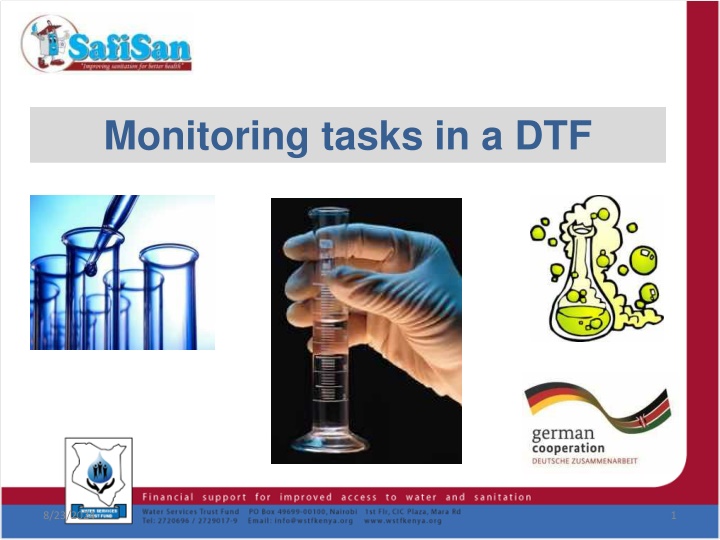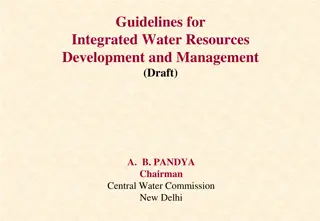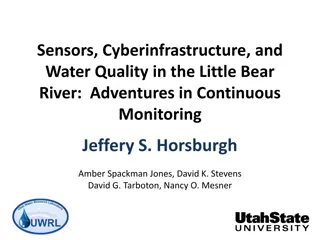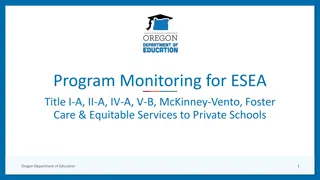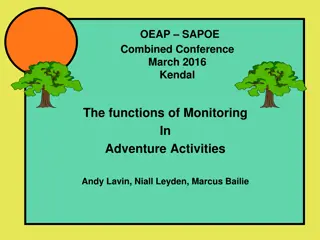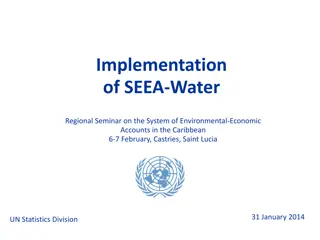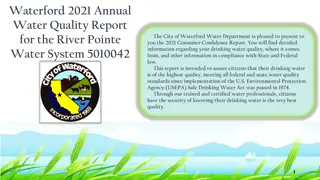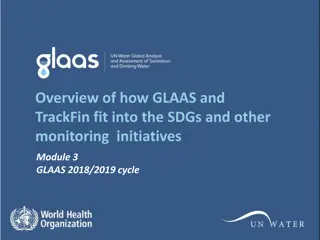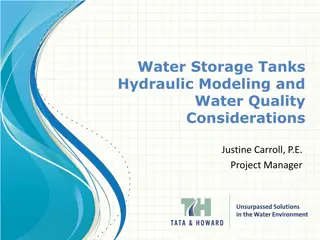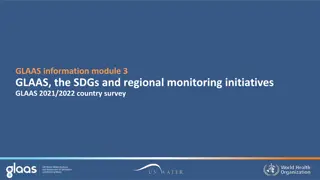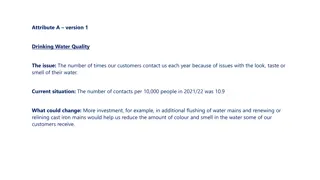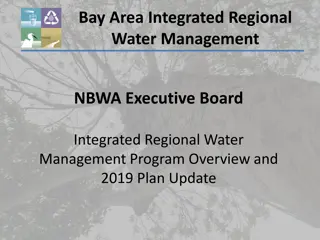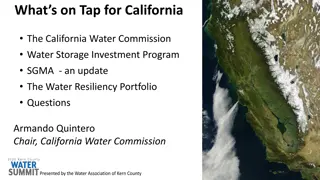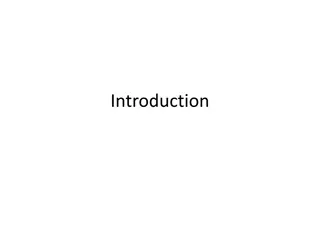Water Quality Monitoring and Procedures for Effective Environmental Management
This document outlines the monitoring tasks, water quality regulation, parameters to be monitored, sample collection locations, and procedures for on-site monitoring in a wastewater treatment facility. It covers essential aspects such as level of sludge and scum, TSS, TDS, BOD5, pH, COD, DO, nitrogen levels, pathogens, turbidity, and odour. The document also provides specific instructions for monitoring sludge and scum levels, turbidity estimation, odour intensity measurement, and testing dissolved oxygen, pH, and temperature for efficient environmental protection. The information presented here is crucial for maintaining water quality standards and ensuring compliance with regulatory requirements.
Download Presentation

Please find below an Image/Link to download the presentation.
The content on the website is provided AS IS for your information and personal use only. It may not be sold, licensed, or shared on other websites without obtaining consent from the author.If you encounter any issues during the download, it is possible that the publisher has removed the file from their server.
You are allowed to download the files provided on this website for personal or commercial use, subject to the condition that they are used lawfully. All files are the property of their respective owners.
The content on the website is provided AS IS for your information and personal use only. It may not be sold, licensed, or shared on other websites without obtaining consent from the author.
E N D
Presentation Transcript
Monitoring tasks in a DTF 8/23/2024 1
Water Quality Regulation 8/23/2024 2
Monitoring parameters On-site (1 / month) External laboratory (1 / 3-6 months) Level of sludge and scum Total Suspended Solid (TSS) Turbidity Total Dissolved Solid (TDS) Odour Biochemical Oxygen Demand (BOD5) pH Chemical Oxygen Demand (COD) Dissolved oxygen (DO) Nitrogen (NH4, NO3, NO2) Temperature Pathogens (E.Coli and Total Coliform) 8/23/2024 3
Location for sample collection Outlet chamber of the Balancing Tank 1 Outlet chamber of the Settler 2 1 Outlet chamber of the ABR 3 Last outlet chamber of the Sludge Drying Beds 2 4 3 Outlet chamber of the Vertical Flow Constructed Wetland 4 5 Upstream A B Downstream 5 B A 8/23/2024 4
Monitoring procedures : on-site Level of sludge and scum Settler tanks Scum layer > 5 cm Sludge layer > 60 cm Remedial actions Remove the scum layer entirely Remove the sludge layer and leave a minimum of 10 cm sludge layer at the bottom Remedial actions Remove the scum layer entirely Remove the sludge layer and leave a minimum of 30 cm sludge layer at the bottom (50 cm in the first 4 chambers) ABR chambers Scum layer > 5 cm Sludge layer > 100 cm 8/23/2024 5
Monitoring procedures : on-site Turbidity: visual estimation It is recommended that the final effluent discharged into the environment (sample no. 5) does not exceed 50 NTU Odour intensity measurement + ++ +++ ++++ +++++ Odour strength Odour: sensorial estimation Barely perceptible Slight Moderate Strong Very strong 8/23/2024 6
Monitoring procedures : on-site Dissolved Oxygen, pH, temperature Measure from a 250-500 ml sample with the following equipment: Thermometer pH strips DO meter The minimum DO value that the final effluent (VFCW outlet) should reach before being released into the environment is 1.5 mg/L Most microorganisms do well within a pH range of 6.5 to 8.5 The optimum efficiency is obtained at a temperature ranging from 10 to 40 C 8/23/2024 7
Monitoring procedures : external laboratory TSS, TDS, BOD5, COD, NH4, NO3, NO2, E.Coli, Total Coliform Parameter BOD5 COD TSS NH4 NO3 NO2 E.Coli Total coliform Results For each sample location, collect a 1000 ml sample in a clean plastic container (free of contaminants). Each sample will be sent to the laboratory to be analysed. If immediate analysis is not possible, refrigerate all the samples to be sent to the laboratory (<4 C but above freezing). Deliver samples to laboratory as soon as practicable after collection, typically within 2 days. 30 (mg/L) max 50 (mg/L) max 30 (mg/L) max 100 (mg/L) max 100 (mg/L) max 100 (mg/L) max Nil/100 ml 1000/100 ml 8/23/2024 8
Proposed list of equipment 1 Lab coat and non-latex gloves box 1 sludge judge + brush 1 sampling rode + 2 plastic cups (500 mL) 1 pH strips box 1 Dissolved Oxygen meter 5 Sampling plastic bottle (1000 mL) 10 glass beaker (250 mL) 1 wash bottle and de-ionized water for rinsing 8/23/2024 9
